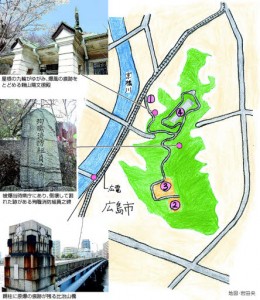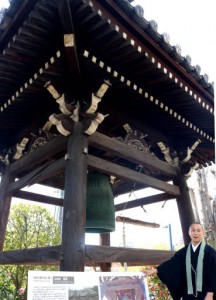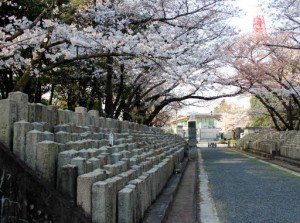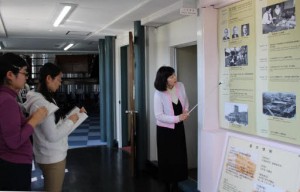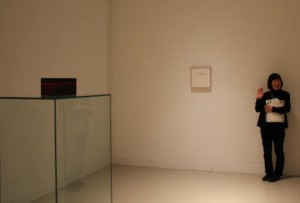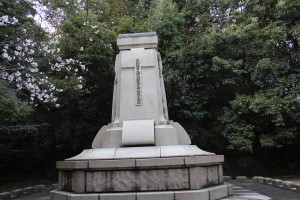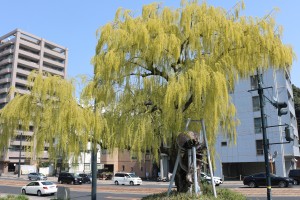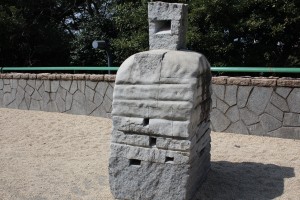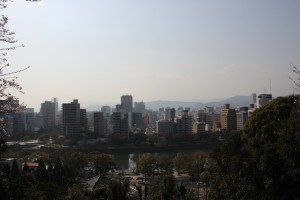Peace Seeds: Teens in Hiroshima Sow Seeds of Peace (Part 55)
Apr. 19, 2018
Part 55: Learning about peace on Hijiyama Hill
Since long ago, Hijiyama Hill Park, located in Minami Ward, Hiroshima, has been known for its beautiful cherry blossoms and for being a place of relaxation for the people of the city. An art museum and library, loved by citizens and tourists, now grace the park, too. In addition, the Radiation Effects Research Foundation, which has investigated the effects of radiation from the atomic bomb for many years, is located here.
During the Meiji Era (1868-1912), a military cemetery was established at this site. In the aftermath of the atomic bombing, which take place on August 6, 1945, a large number of people fled to Hijiyama Hill, located about 2 kilometers from the bomb’s hypocenter. Overlooking the city center, the hill is still dotted with scars from the atomic bombing. The City of Hiroshima is now moving forward with a plan to reorganize Hijiyama Hill Park into the “Hill for Peace.”
The junior writers of the Chugoku Shimbun took a walk around Hijiyama Hill this spring and created a map to help visitors better understand its connections to war and peace.
A sorrowful walk
1. Tamonin Temple
The bell tower that survived the atomic bombing conveys its horror
Tamonin Temple, which stands at the foot of Hijiyama Hill, is located 1.75 kilometers from the hypocenter. The city’s temporary air defense headquarters was set up at this temple on the day of the atomic bombing. The main hall and priests’ quarters were badly damaged, but the bell tower, which was built in 1934, survived the bomb’s massive blast and has been maintained with great care. The torn roofs and broken beams convey the horror of the A-bomb attack.
At the time of the bombing, the bell tower did not hold a bell because it had been surrendered along with other Buddhist altar fittings due to a shortage of metal during the war. But in 1949, the chief priest at the time mounted a “peace bell” which was made by mixing in sand that came from the hypocenter. The words “NO MORE HIROSHIMAS” are inscribed on its surface.
Nowadays, Taiko Kameo, 35, the vice priest of the temple, strikes the bell at 8:15 every morning, the time that the atomic bomb exploded. Mr. Kameo said, “When August 6 approaches, I get a strange feeling every time I strike the bell.” He said that the morning of that day, when people’s daily lives were suddenly lost in a flash, has become a sharper reality.
I struck the bell, too. When I did, I could feel the sound in my stomach and I savored its soothing resonance. Mr. Kameo hopes that the time of 8:15 will be appreciated by as many people as possible. The sound of the bell at Tamonin Temple continues to convey the wish for peace. (Kana Okino, 18)
2. The Hijiyama Army Cemetery
Deaths of soldiers must not be forgotten
The Hijiyama Army Cemetery was established as a burial place for soldiers in 1872, and the remains of war dead were buried here after the Satsuma Rebellion in 1877. The graves were arranged in 1944, but suffered a state of disarray for some time after the war because of the atomic bombing and the Makurazaki Typhoon.
The cemetery today, surrounded by cherry trees, was rebuilt by volunteers in 1960. The graves are arranged by prefecture and stand side by side. There are also graves for French, German, and Chinese nationals who were victims of war, including the Sino-Japanese War and World War I, as well as various memorial monuments.
It was the first time that I walked through the cemetery. Each grave marks the life of a soldier who has passed away. I felt a strong desire to help prevent the memories of war from fading. There are many historic sites on Hijiyama Hill that recall the atomic bombing. The military cemetery conveys the grief of war from a different point of view. (Yukiho Saito, 16)
3. The Radiation Effects Research Foundation
Continuing health surveys of A-bomb survivors
The Radiation Effects Research Foundation (RERF) was originally established as the Atomic Bomb Casualty Commission (ABCC) by the United States. It was first established in the Hiroshima Red Cross Hospital in 1947 and the current buildings were completed in Hijiyama Park in 1950. This location was chosen because flooding frequently occurred on the flat land in the downtown area. In 1975, the organization became a research institute jointly managed by the Japanese and U.S. governments.
In its early days, RERF gave medical examinations to children and young women who had experienced the atomic bombing, even though they were unwilling to undergo these examinations. RERF staff also conducted autopsies on the bodies of A-bomb survivors. The organization came under criticism for only investigating the bomb’s effects and not providing any medical treatment to the survivors.
Jeffrey Hart, 58, chief of the Public Relations and Publications Office, said that RERF is a research institute and that treatment had not been one of its aims. Nevertheless, he said he felt terrible about the organization’s earlier history, particularly when children were forced to undergo examinations.
After 1958, RERF began to track the cause of death and the life span of A-bomb survivors. Based on this data, standards for radiation exposure used in medical treatment and for other purposes were determined. Mr. Hart stressed that various kinds of research on radiation has been pursued with the help and cooperation of A-bomb survivors.
RERF is also involved in studying the health conditions of A-bomb survivors and whether or not their radiation exposure has had an effect on second-generation survivors. The organization works closely with young people and disseminates information through presentations at schools and on its Facebook page. My visit to the RERF facility helped me understand the history and the current state of this research institute. (Hisashi Iwata, 17)
4. The Hiroshima City Museum of Contemporary Art
Shocked by the artwork of Yoko Ono
The Hiroshima City Museum of Contemporary Art opened in Hijiyama Park in 1989. Many works of art on the theme of the atomic bomb, war, and peace, created by artists from a range of countries, are found in the museum’s collection.
The piece “HAKO” (“Box”), created by Yoko Ono for the 50th anniversary of the A-bomb attack, is a small, bloodstained box with a poem that reads: “I can’t escape from the pain.” This sentiment expresses the endless suffering of the A-bomb survivors. When I looked at this piece, I felt like moving away quickly and, at the same time, I sensed how the people who were actually wounded in the bombing have always borne this burden.
The ceiling of the entrance to the museum is designed with a crevice that points in the direction of the A-bomb’s hypocenter and a portion of the building’s pillars are made of A-bombed stones. This is a museum where people can turn their thoughts toward peace. (Shiho Fujii, 16)
What is Peace Seeds?
Peace Seeds are the seeds of smiles which can be spread around the world by thinking about peace and the preciousness of life from various viewpoints. To fill this world with flowering smiles, junior writers, 25 junior high and high school students, choose themes, gather information, and write articles.
(Originally published on April 19, 2018)
Since long ago, Hijiyama Hill Park, located in Minami Ward, Hiroshima, has been known for its beautiful cherry blossoms and for being a place of relaxation for the people of the city. An art museum and library, loved by citizens and tourists, now grace the park, too. In addition, the Radiation Effects Research Foundation, which has investigated the effects of radiation from the atomic bomb for many years, is located here.
During the Meiji Era (1868-1912), a military cemetery was established at this site. In the aftermath of the atomic bombing, which take place on August 6, 1945, a large number of people fled to Hijiyama Hill, located about 2 kilometers from the bomb’s hypocenter. Overlooking the city center, the hill is still dotted with scars from the atomic bombing. The City of Hiroshima is now moving forward with a plan to reorganize Hijiyama Hill Park into the “Hill for Peace.”
The junior writers of the Chugoku Shimbun took a walk around Hijiyama Hill this spring and created a map to help visitors better understand its connections to war and peace.
A sorrowful walk
1. Tamonin Temple
The bell tower that survived the atomic bombing conveys its horror
Tamonin Temple, which stands at the foot of Hijiyama Hill, is located 1.75 kilometers from the hypocenter. The city’s temporary air defense headquarters was set up at this temple on the day of the atomic bombing. The main hall and priests’ quarters were badly damaged, but the bell tower, which was built in 1934, survived the bomb’s massive blast and has been maintained with great care. The torn roofs and broken beams convey the horror of the A-bomb attack.
At the time of the bombing, the bell tower did not hold a bell because it had been surrendered along with other Buddhist altar fittings due to a shortage of metal during the war. But in 1949, the chief priest at the time mounted a “peace bell” which was made by mixing in sand that came from the hypocenter. The words “NO MORE HIROSHIMAS” are inscribed on its surface.
Nowadays, Taiko Kameo, 35, the vice priest of the temple, strikes the bell at 8:15 every morning, the time that the atomic bomb exploded. Mr. Kameo said, “When August 6 approaches, I get a strange feeling every time I strike the bell.” He said that the morning of that day, when people’s daily lives were suddenly lost in a flash, has become a sharper reality.
I struck the bell, too. When I did, I could feel the sound in my stomach and I savored its soothing resonance. Mr. Kameo hopes that the time of 8:15 will be appreciated by as many people as possible. The sound of the bell at Tamonin Temple continues to convey the wish for peace. (Kana Okino, 18)
2. The Hijiyama Army Cemetery
Deaths of soldiers must not be forgotten
The Hijiyama Army Cemetery was established as a burial place for soldiers in 1872, and the remains of war dead were buried here after the Satsuma Rebellion in 1877. The graves were arranged in 1944, but suffered a state of disarray for some time after the war because of the atomic bombing and the Makurazaki Typhoon.
The cemetery today, surrounded by cherry trees, was rebuilt by volunteers in 1960. The graves are arranged by prefecture and stand side by side. There are also graves for French, German, and Chinese nationals who were victims of war, including the Sino-Japanese War and World War I, as well as various memorial monuments.
It was the first time that I walked through the cemetery. Each grave marks the life of a soldier who has passed away. I felt a strong desire to help prevent the memories of war from fading. There are many historic sites on Hijiyama Hill that recall the atomic bombing. The military cemetery conveys the grief of war from a different point of view. (Yukiho Saito, 16)
3. The Radiation Effects Research Foundation
Continuing health surveys of A-bomb survivors
The Radiation Effects Research Foundation (RERF) was originally established as the Atomic Bomb Casualty Commission (ABCC) by the United States. It was first established in the Hiroshima Red Cross Hospital in 1947 and the current buildings were completed in Hijiyama Park in 1950. This location was chosen because flooding frequently occurred on the flat land in the downtown area. In 1975, the organization became a research institute jointly managed by the Japanese and U.S. governments.
In its early days, RERF gave medical examinations to children and young women who had experienced the atomic bombing, even though they were unwilling to undergo these examinations. RERF staff also conducted autopsies on the bodies of A-bomb survivors. The organization came under criticism for only investigating the bomb’s effects and not providing any medical treatment to the survivors.
Jeffrey Hart, 58, chief of the Public Relations and Publications Office, said that RERF is a research institute and that treatment had not been one of its aims. Nevertheless, he said he felt terrible about the organization’s earlier history, particularly when children were forced to undergo examinations.
After 1958, RERF began to track the cause of death and the life span of A-bomb survivors. Based on this data, standards for radiation exposure used in medical treatment and for other purposes were determined. Mr. Hart stressed that various kinds of research on radiation has been pursued with the help and cooperation of A-bomb survivors.
RERF is also involved in studying the health conditions of A-bomb survivors and whether or not their radiation exposure has had an effect on second-generation survivors. The organization works closely with young people and disseminates information through presentations at schools and on its Facebook page. My visit to the RERF facility helped me understand the history and the current state of this research institute. (Hisashi Iwata, 17)
4. The Hiroshima City Museum of Contemporary Art
Shocked by the artwork of Yoko Ono
The Hiroshima City Museum of Contemporary Art opened in Hijiyama Park in 1989. Many works of art on the theme of the atomic bomb, war, and peace, created by artists from a range of countries, are found in the museum’s collection.
The piece “HAKO” (“Box”), created by Yoko Ono for the 50th anniversary of the A-bomb attack, is a small, bloodstained box with a poem that reads: “I can’t escape from the pain.” This sentiment expresses the endless suffering of the A-bomb survivors. When I looked at this piece, I felt like moving away quickly and, at the same time, I sensed how the people who were actually wounded in the bombing have always borne this burden.
The ceiling of the entrance to the museum is designed with a crevice that points in the direction of the A-bomb’s hypocenter and a portion of the building’s pillars are made of A-bombed stones. This is a museum where people can turn their thoughts toward peace. (Shiho Fujii, 16)
What is Peace Seeds?
Peace Seeds are the seeds of smiles which can be spread around the world by thinking about peace and the preciousness of life from various viewpoints. To fill this world with flowering smiles, junior writers, 25 junior high and high school students, choose themes, gather information, and write articles.
(Originally published on April 19, 2018)

